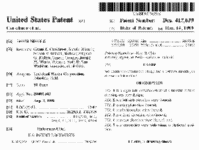


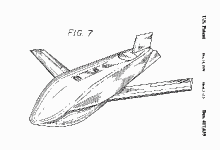
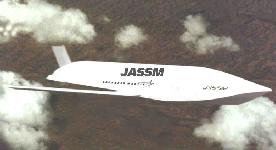
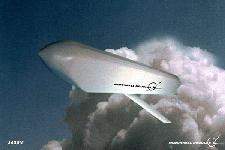
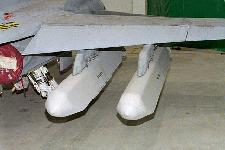

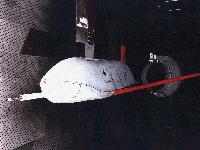
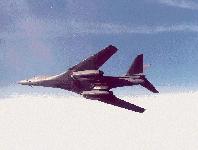
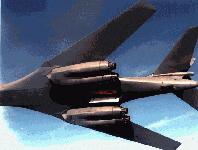
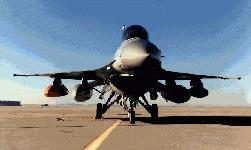
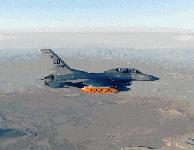
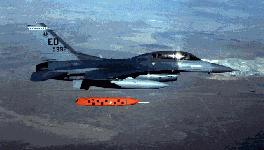

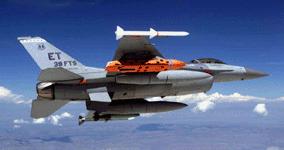



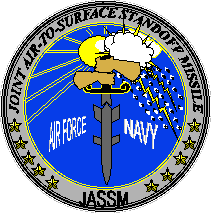
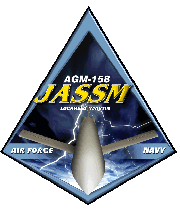 The Air Force/Navy Joint Air to Surface Standoff Missile (JASSM) program was established in the fiscal year 1996 budget, following cancellation of the Tri-Service Stand-off Attack Missile (TSSAM), to develop a replacement for that
system at the earliest possible date. In light of the urgent need for the operational capability that would have been provided by the TSSAM, the Secretary of Defense established a joint program in the Air Force and the Navy for development of a replacement for TSSAM, canceled for escalating program cost, that would meet the requirements of both services. After the termination of the TSSAM, the Services continued to reiterate the need for a high survivability standoff weapon capable of attacking a variety of deep interdiction type targets. The Joint Requirements Oversight Council revalidated the need for the weapon in an August 1995 mission need statement.
JASSM is a precision cruise missile designed for launch from outside area defenses to kill hard, medium-hardened, soft, and area type targets. The threshold integration aircraft are the F-16, B-52, and F/A-18 E/F, and the airframe design is compatible with all JASSM launch platforms: the B-52H, F-16C/D, F/A-18E/F, F-15E, F-117, B-1B, B-2, P-3C and S-3B.
The weapon is required to attack both fixed and relocatable targets at ranges beyond enemy air defenses. After launch, it
will be able to fly autonomously over a low-level,
circuitous route to the area of a target, where an
autonomous terminal guidance system will guide the missile in for a direct hit.
The key performance parameters for the system are Missile Mission Effectiveness, range, and carrier operability.
The Air Force/Navy Joint Air to Surface Standoff Missile (JASSM) program was established in the fiscal year 1996 budget, following cancellation of the Tri-Service Stand-off Attack Missile (TSSAM), to develop a replacement for that
system at the earliest possible date. In light of the urgent need for the operational capability that would have been provided by the TSSAM, the Secretary of Defense established a joint program in the Air Force and the Navy for development of a replacement for TSSAM, canceled for escalating program cost, that would meet the requirements of both services. After the termination of the TSSAM, the Services continued to reiterate the need for a high survivability standoff weapon capable of attacking a variety of deep interdiction type targets. The Joint Requirements Oversight Council revalidated the need for the weapon in an August 1995 mission need statement.
JASSM is a precision cruise missile designed for launch from outside area defenses to kill hard, medium-hardened, soft, and area type targets. The threshold integration aircraft are the F-16, B-52, and F/A-18 E/F, and the airframe design is compatible with all JASSM launch platforms: the B-52H, F-16C/D, F/A-18E/F, F-15E, F-117, B-1B, B-2, P-3C and S-3B.
The weapon is required to attack both fixed and relocatable targets at ranges beyond enemy air defenses. After launch, it
will be able to fly autonomously over a low-level,
circuitous route to the area of a target, where an
autonomous terminal guidance system will guide the missile in for a direct hit.
The key performance parameters for the system are Missile Mission Effectiveness, range, and carrier operability.
JASSM's midcourse guidance is provided by a Global Positioning System (GPS)-aided inertial navigation system (INS) protected by a new high, anti-jam GPS null steering antenna system. In the terminal phase, JASSM is guided by an imaging infrared seeker and a general pattern match-autonomous target recognition system that provides aimpoint detection, tracking and strike. It also offers growth potential for different warheads and seekers, and for extended range.
Initially, the program entertained proposals from seven contractors. The build-up to the Request for Proposal release was a period of intense interaction between all contractors and the government team. A 24-month JASSM Program Definition and Risk Reduction contract was awarded to McDonnell Douglas by the Department of Defense on June 17, 1996. A downselect to one contractor for the engineering and manufacturing development and full-rate production phases occured in April 1998 with the selection of Lockheed-Martin. The Navy has proposed to replace the joint program for JASSM with the Navy's SLAM-ER, prior to completion of the current program definition and risk reduction phase for JASSM. The proposal is one of the program alternatives that may be considered at the Milestone II review for entry of the JASSM program into engineering and manufacturing development in July 1998, which will evaluate the technical progress in the program and risk reduction phase, cost and operational effectiveness analysis, and other factors.
Low-rate initial production decision for JASSM is in the year 2000, with full-scale production scheduled to run from 2002 to 2009. Total missile production for the U.S. Air Force is expected to be 2,400 missiles; the total for the U.S. Navy is yet to be determined. The total program is valued at approximately $3 billion.
The JASSM Penetrator concept is a P3I to the Joint Air-to-Surface Standoff Missile (JASSM) to replace the baseline warhead with an advanced penetrator that meets or exceeds the objective penetration requirement specified in the JASSM Operational Requirements Document (ORD) and to add a synthetic aperture radar (SAR) seeker for adverse weather precision attack capability. The warhead concept is a 1000 pound dense or ballasted penetrator. The warhead would either be designed with a dense metal case or contain dense metal ballast for maximum penetration. The warhead will be filled with advanced insensitive explosive to compensate for the reduced charge weight. The JASSM will be compatible with the B-52, F-16, F/A-18 (threshold), B-1, B-2, F-15E, F-117, S3, P3 and JSF (objective). This concept uses the Hard Target Smart Fuze (HTSF), an accelerometer based electronic fuze which allows control of the detonation point by layer counting, distance or time. The accelerometer senses G loads on the bomb due to deceleration as it penetrates through to the target. The fuze can distinguish between earth, concrete, rock and air.
In December 1998 the development of JASSM was slowed, following concerns that the program�s development schedule was "too aggressive." The engineering and manufacturing development (EMD) phase was extended from 34 to 40 months. Another reason given for the extended schedule was that the Theater Battle Management Core System, on which the JASSM will rely, is not yet year 2000-compliant. The JASSMs, costing approximately $300,000 per unit, will be tested beginning in February 1999 at Eglin and at White Sands Missile Range.
Specifications | |
| Missions | |
| Targets | hard, medium-hardened, soft, and area fixed and relocatable targets |
| Service | Air Force |
| Program status | |
| First capability | |
| Guidance method | Global Positioning System (GPS)-aided inertial navigation system (INS) |
| Range | nautical miles |
| Quantity | usaf - 2,400 USN - TBD |
| Development cost | $ million |
| Production cost | $ million |
| Total acquisition cost | $ 3 Billion |
| Acquisition unit cost | $ million |
| Production unit cost | $700,000 |
| Platforms |
B-52 (12) FY01 B-1 (24) FY02 B-2 (16) FY03 F-16 (2) FY04 F-16C/D F/A-18E/F F-15E F-117 P-3C S-3B |















